only to sit on a park bench all day.
Getting stuck in denial is common in 'cool' cultures (such as in
Britain, particularly Southern England) where expressing anger
is not acceptable. The person may feel that anger, but may then
repress it, bottling it up inside.
Likewise, a person may be stuck in permanent anger (which is
itself a form of flight from reality) or repeated bargaining. It is
more difficult to get stuck in active states than in passivity, and
getting stuck in depression is perhaps a more common ailment.
Going in cycles
Another trap is that when a person moves on to the next phase,
they have not completed an earlier phase and so move
backwards in cyclic loops that repeat previous emotion and
actions. Thus, for example, a person that finds bargaining not to
be working, may go back into anger or denial.
Cycling is itself a form of avoidance of the inevitable, and going
backwards in time may seem to be a way of extending the time
before the perceived bad thing happens.
Source: Elisabeth Kübler-Ross, On Death and Dying, Macmillan,
NY, 1969
http://changingminds.org/disciplines/change_management/ku
bler_ross/kubler_ross.htm
1093
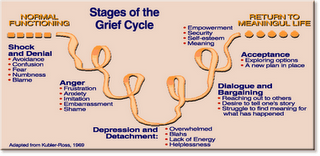
Examples.
Shock and Denial.
"This can't be happening, not to me."; "I don't have true
infertility since I've already had a child."
Denial is a conscious or unconscious refusal to accept facts,
information, reality, etc., relating to the situation concerned. It's
a defence mechanism and perfectly natural. Some people can
become locked in this stage when dealing with a traumatic
change that can be ignored.
Anger.
"Why me? After all I've been through. It's not fair!"; "How can
this happen to me?"; '"Who is to blame?"
Anger can manifest in different ways. People dealing with
emotional upset can be angry with themselves, and/or with
others, especially those close to them. Knowing this helps keep
detached and non-judgemental when experiencing the anger of
someone who is very upset.
1094
Bargaining.
"Please God. I would give anything."; "If I don't get pregnant we
will just adopt, either way it will happen."; "I know there must
be a reason this is happening."
Traditionally the bargaining stage for people facing
death can involve attempting to bargain with whatever God the
person believes in. People facing less serious trauma can bargain
or seek to negotiate a compromise. For example "Can we still be
friends?.." when facing a break-up. Bargaining rarely provides a
sustainable solution, especially if it's a matter of life or death.
Depression.
"I'm so sad, why bother with anything?"; "No matter what I do
it's just not going to happen."; "Why try anymore?"; "Everyone is
moving on without me."
During the fourth stage, the dying person begins to
understand the certainty of death. Because of this, the individual
may become silent, refuse visitors and spend much of the time
crying and grieving. This process allows the dying person to
disconnect from things of love and affection. It is not
recommended to attempt to cheer up an individual who is in this
stage. It is an important time for grieving that must be processed.
Acceptance.
"It's going to be okay."; "There's nothing I can do to change it so
why stay bitter?"; "It will happen eventually."
In this last stage, individuals begin to come to terms with
their mortality, or that of a loved one, or other tragic event.
1095
Not everyone even that has gone through infertility, loss of a
loved one, or a preemie may experience these stages. Some are
strong enough to be in acceptance for most of the time...oh gosh
how I wish I could be that strong. Some will deny it until those
two lines appear or until their baby comes home. But I can
guarantee that I have felt each stage and most do. Some days its
easy to accept and other days I just refuse to accept this. Either
way I will be real about those feelings be that good, bad or ugly.
And I refuse to apologize for that.
http://drawingablake.blogspot.com/2011/12/grief-cycle-and-
loss-of-control.html
Recognizing Grief Over the Loss of Income
Shock and denial are the first reactions of people
experiencing unplanned changes.
When people experience a major income loss they go through
certain stages of grief. Figure 2 shows these and what happens at
each stage. People often move back and forth between the stages
and sometimes get stuck at a particular stage for a while.
To express anger in a positive way, people need to change
how they view the situation.
Stage 1 - Shock and Denial
Shock and denial are the first reactions of people experiencing
unplanned changes. At this stage in the loss cycle, it is normal for
people to feel confused and afraid, and to want to place blame.
However, many people are just numb when facing an unplanned
change as if they were on automatic pilot. It is very common for
people to avoid making decisions or taking action at this point.
1096

Figure 2. Stages of the Grief Cycle
People are often unable to function or perform simple, routine
tasks during this stage.
Denial can occasionally be healthy for a short time, but
prolonged denial can have devastating consequences for the
person and for the situation. Denial of something that has
happened or of the pain and fear being experienced is a way in
which people protect themselves when faced with a painful
situation. Continued denial of the pain and fear, however, will
block them from doing something about it.
1097
Stage 2 - Anger
Anger is a feeling that is often intensely felt during this time.
Anger is identified by feelings of second-guessing, hate, self-
doubt, embarrassment, irritation, shame, hurt, frustration, and
anxiety. People usually understand more clearly what is
happening, but they may look for someone to blame at this stage.
If there is no one on whom to focus the anger or blame, a feeling
of helplessness may take over and the anger may be turned
inside. Some people take it out on themselves by taking
responsibility for a situation over which they have had little
control.
People are often afraid that if they let themselves acknowledge
the anger they feel, they will immediately need to express it and
act on it in a way that they will regret later. However, by not
admitting to themselves and others close to them the loss and
pain they feel, they will be blocked from doing something about
the situation. It will also prevent them from moving on. Some
people get stuck at this stage.
To express anger in a positive way, people need to change how
they view the situation. It is also helpful to talk to others about it
or write down their feelings in order to figure out what they
need to do to make the feelings less intense. Another option is to
turn the anger into energy through an active sport or brisk
physical activity or to express it through playing a musical
instrument.
Stage 3 - Depression and Detachment
The third stage of the loss cycle, depression and detachment, is
characterized by feelings of helplessness, hopelessness, and
being overwhelmed. People often feel down, lack energy, and
have no desire to do anything. Withdrawal from activities and
other people is common. Because it is also hard to make
1098
decisions at this stage, ask a family member, friend, or
professional to help you if important decisions need to be made.
Stage 4 - Dialogue and Bargaining
The fourth stage, dialogue and bargaining, is a time when people
struggle to find meaning in what has happened. They begin to
reach out to others and want to tell their story. People become
more willing to explore alternatives after expressing their
feelings. They may, however, still be angry or depressed. People
do not move neatly from one stage to another. Rather, the stages
overlap and people often slip back to earlier stages.
Stage 5 - Acceptance
At this stage, people are ready to explore and consider options.
As the acceptance stage progresses, a new plan begins to take
shape or, at the very least, people are open to new options.
Getting Back to "Normal"
A person's "normal" state of functioning becomes disrupted by a
sudden income loss. It is possible to return to a purposeful state
of functioning after going through the stages described above
and after exploring options and setting a plan. People then begin
to feel secure and in control and have a more positive self-
esteem. People get renewed energy to tackle life again but in
different ways than before the sudden income change. It is
perhaps better to think of the end of the grief cycle as returning
to a meaningful life rather than returning to a "normal" life.
"Normal" at this stage will not be the same as "normal" before
the loss.
Source: University of Minnesota
http://www.extension.umn.edu/distribution/businessmanagem
ent/components/06499c.html
1099
4.13 Knowing and Not Knowing
If I don't know I don't know
I think I know
If I don't know I know
I think I don't know
Laing R D (1970) Knots Harmondsworth; Penguin (p.55)
"He that knows not, and knows not that he knows not is a fool.
Shun him
He that knows not, and knows that he knows not is a pupil.
Teach him.
He that knows, and knows not that he knows is asleep
Wake him.
He that knows, and knows that he knows is a teacher.
Follow him."
(Arabic proverb)
NEIGHBOUR R (1992) The Inner Apprentice London; Kluwer
Academic Publishers. p.xvii
"We know what we know, we know that there are things we do
not know, and we know that there are things we don't know we
don't know"
Donald Rumsfeld (4 Sept 2002) (Woodward, 2004: 171)
It is ironic, perhaps, that the initial insight is allegedly Arabic.
This paper is playing around with a conceit: two senses of the
term "know". However, it is all in a professional cause.
1100

The two senses are those of:
awareness of self, (represented by the vertical red line
in the diagram below) and
knowledge of the world (the horizontal blue line)
There are of course four possible combinations, which are
explored below.
You may find parallels with the witting and willing practice
model, and also with the familiar "unconscious incompetence"
to "unconscious competence" model. which relates primarily to
practical skills: here we are exploring knowledge. Laing's poetic
exploration of its interpersonal convolutions cited above (it goes
on for another 21 pages), and the citation of the idea by
Neighbour (1992) credited as an Arabic proverb demonstrate
that it has a considerable provenance.
1101

Not knowing you don't know
The first possibility is that of being unaware that you don't know
something. This is the "ignorance is bliss" state, enjoyed by
everyone who pontificates about politics in pubs. It is also the
position of many people on "soft" occupations (such as teaching,
or social work) which look from the outside as if "any fool could
do it". (Some do.) And it is engendered by consummate
professionals who make what they do look easy (such as
plasterers and chefs and popular novelists and...).
Many students start from this position, and although the
Neighbour proverb calls them "fools", it is not really fair. Let's go
on —
So the first move is often to make learners aware of their
ignorance. This is tricky, in practice. Unless they are a captive
audience it is quite easy to frighten them off. (It is also quite
seductive, because it is a chance to show off your own level of
knowledge or competence.) On the other hand, it is a crucial step
in developing motivation to learn.
1102
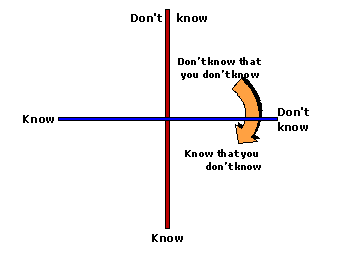
There are various ways of doing it.
In my first German lesson, a young teacher recited a poem
to us in German: it sounded great, but we couldn't
understand a word of it, of course. He didn't really need to
do it, because we already knew we didn't know any of it
apart from a couple of phrases picked up from war films.
He was trying to show what we might aspire to, and went
on to explain that. (It must have made an impact because I
can remember the lesson fifty years later.)
You can ask a student (usually either one who is a bit
full of himself and needs to be "taken down a peg", or
one who is mature enough not to be humiliated) to do
something practical in the certainty that he will fail.
Only do this if you are confident that when you do it, as
you will be challenged to, you can manage it yourself.
You can pose a problem which has a seemingly simple
answer (political, economic, legal—or in Neighbour's
case, medical), and then show the problems in reaching
1103
that simple solution, which stem from ignorance of the
context.
The trick is to show something which is (so far) beyond the
students' reach, but not so far beyond it that they will despair.
The second trick is to make it interesting. I have deliberately not
mentioned strategies for doing this in accountancy.
More significantly:
In continuing professional development courses in
particular, you may be challenging survival-oriented
practice in which people have a substantial vested
interest: this is the key to the whole un-
learning/learning process.
Unless you have to do it, don't. Many learners
(particularly those who have signed up for your course
of their own free will) are only too aware of what they
don't know. The last thing they need is for you to rub it
in.
Skill in this area is of course a core competence for
charlatans. Whether self-help gurus who must convince
you of your personal inadequacy or potential ill-health,
religious proselytisers who must convict you of sins
only they believe are sinful, or salespeople who have to
create a "need" for their product, they all have to
manage this stage. Study and learn from them—just
don't believe them.
1104
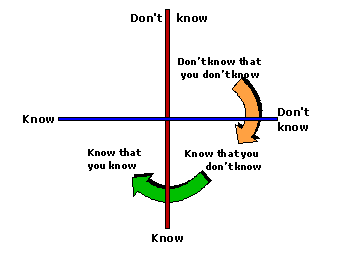
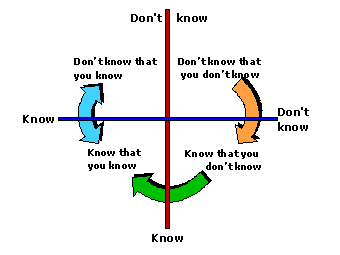
Knowing you don't know
This move, from "knowing that you don't know" to "knowing
that you know" is what most learning and hence teaching is all
about.
1105
Knowing and not knowing that you know
The interaction between knowing and not knowing that you
know is however more complex and much neglected.
There are two kinds of knowledge (in a third sense) or
practice involved here.
The first is that for which the move to "not knowing
that you know" or "unconscious competence" is the
highest stage of development. This applies to the basic
skills of driving, or knitting; the kind of thing you can
"do without thinking".
The second is where people who have informally
learned a great deal mistakenly put themelves in the
"knowing that they don't know" category because they
have never received any academic or professional
accreditation for their learning. This is the downside of
our qualification-driven culture, which dismisses those
whom Gramsci called "organic intellectuals" because
they do not have the recognition of the formal
educational system.
Neighbour's Arabic proverb enjoins us to "awaken"
someone in this position, which means to take them
back, counter-clockwise on the diagram, to an
awareness of their knowledge. There is a link here with
Mezirow's concept of "transformative learning", in
which education leads to a re-evaluation of life so far.
(There is perhaps a third possibility here, too, which is
the fit with the willing but unwitting category in the
model of practice on this site.)
1106
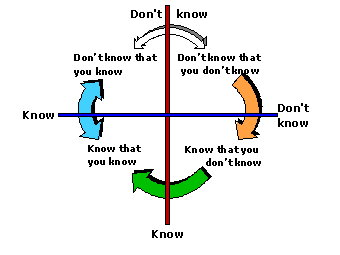
The problematic expert
The fourth possibility is touched on in the discussion of
expertise.This the person who (wait for it!) knows that she knows
but does not know how she knows—or cannot express it. Ask
about a particularly brilliant bit of practice and you will get a
banal answer which might have come out of the textbook, but
which totally fails to do justice to the complexity of what she has
done. Sometimes that answer will be given because she does not
want to appear a "smart-arse" ("Ass" if you are American, but I
wouldn't wish to confuse you with references to donkeys.)
Sometimes, though, she might claim that it is a matter of "not
being able to put it into words" or even, disconcertingly, of a
"hunch".
She may even be afraid of trying to express her expertise, for fear
that an inadequate exposition will somehow jeopardise fragile
knowledge. Once she has said it, it might become ossified. She
might feel obliged to live up to her exposition and limit that
insight and creativity which goes beyond words.
Some things we can teach, and some we can't.
1107
So that's the whole story. Or is it? Is there any connection
between the "Don't know that you know" stage and the "Don't
know that you don't know" stage? Possibly (but not always).
There may occasionally be a cycle: if you don't know
what you do know, you probably don't know what you
don't know, either. This may be the case for people who
are stuck at a survival learning level. They have learned
to get by with what they know, to the extent that they
do not give themselves credit for it, or are even
unaware of knowing it, as we have discussed. However,
they can't take it any further because it is out of
awareness, so they are unaware of how they could
move on from mere competence or proficiency to real
expertise.
For such people, because they do not know what they
know, they may be unsure of their knowledge, and may
be threatened by the prospect of moving on, which
leads to a degree of resistance to new learning.
The Bottom Line
Clearly we have to get people to realise what they don't know, if
necessary. But fascinating though it is, the inarticulate expertise
of not knowing that you know is a dead end from the learning
and teaching point of view. The only open position, with
potential for development, is that of knowing what you know.
Sources:
http://www.trainer.org.uk/members/theory/
process/stages_of_learning.htm
http://www.neurosemantics.com/Articles/
Unconscious.htm
http://www.nlp.org/glossary.html#U
Dubin, P (1962) 'Human Relations in Administration',
Englewood Cliffs, NJ, Prentice-Hall
1108
Kirkpatrick, D. L. (1971). A practical guide for supervisory
training and development. Reading, MA: Addison-Wesley
Publishing Co.
There's a fascinating exploration of the whole story at
http://www.businessballs.com/consciouscompetencelearn
ingmodel.htm
The medical school at the University of Arizona has taken similar
ideas further with their Curriculum on Medical Ignorance (CMI)
and developed the Q-Cubed; Questions, questioning and
questioners project. Here is their "Ignorance Map", which
identifies:
Known Unknowns: all the things you know you don't
know.
Unknown Unknowns: all the things you don't know you
don't know
Errors: all the things you think you know but don't
Unknown Knowns: all the things you don't know you
know
Taboos: dangerous, polluting or forbidden knowledge
Denials: all the things too painful to know, so you don't
[acknowledgements to Perkins D (2009) Making Learning
Whole: how seven principles of teaching can transform
education San Francisco; Jossey Bass p 241 for the link.]
Ref: WOODWARD B (2004) Plan of Attack New York; Simon and
Schuster
1109
Source:
Atherton J S (2011) Doceo; Knowing and not knowing [On-line:
UK] retrieved 1 February 2012 from
http://www.doceo.co.uk/tools/knowing.htm
Read
more:
Knowing
and
not
knowing
http://www.doceo.co.uk/tools/knowing.htm#ixzz1l7YFrgpN
Under Creative Commons License: Attribution Non-Commercial
No Derivatives
conscious competence learning model
stages of learning - unconscious incompetence to
unconscious competence - and other theories and models for
learning and change
Here first is the 'conscious competence' learning model and
matrix, and below other other theories and models for learning
and change.
The earliest origins of the conscious competence theory are not
entirely clear, although the US Gordon Training International
organisation has certainly played a major role in defining it and
and promoting











